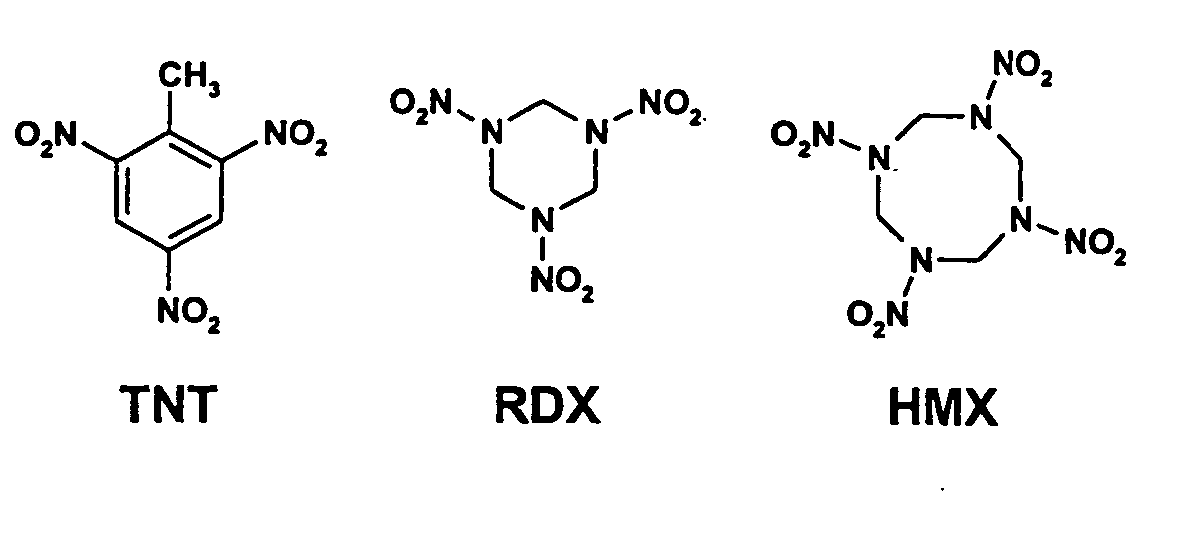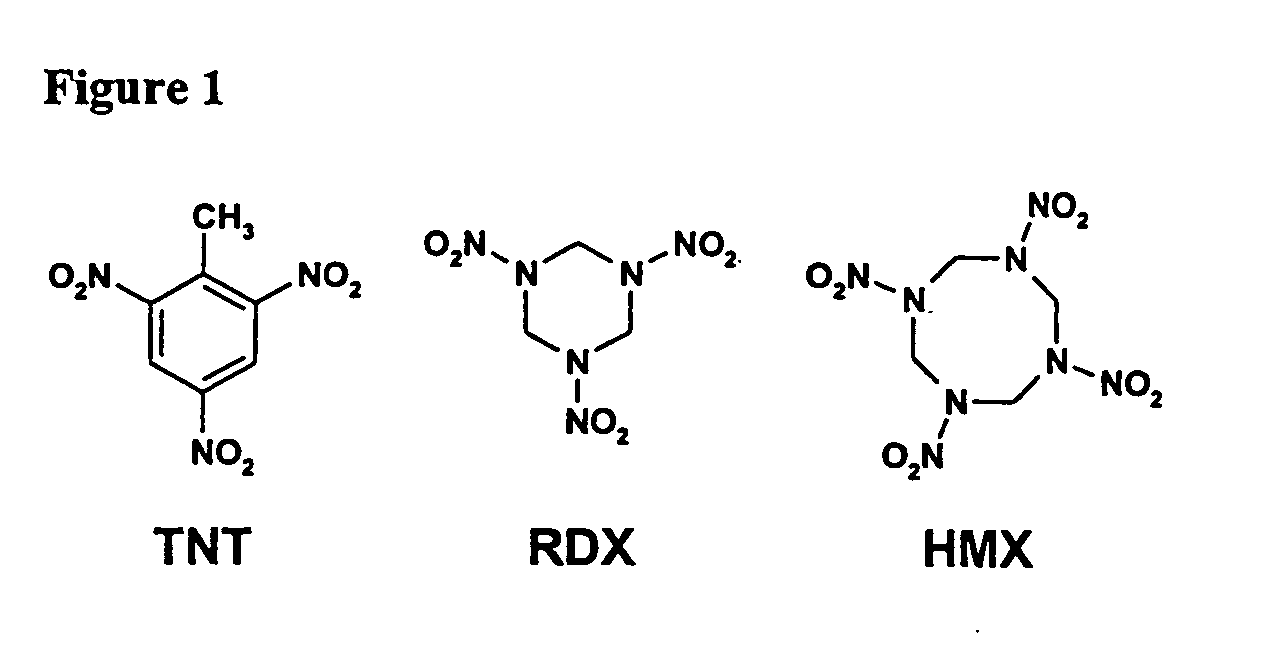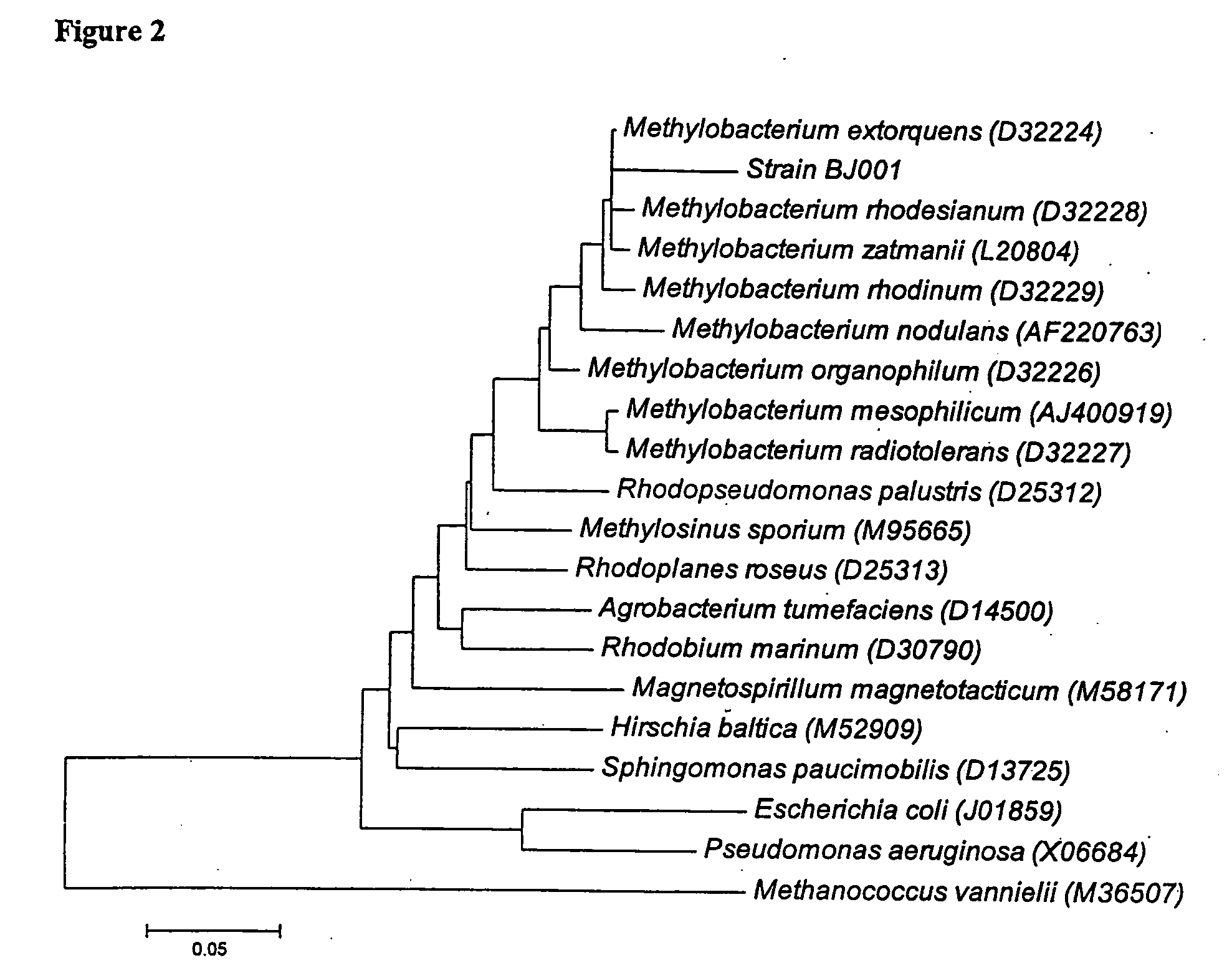Methods and compositions for degradation of nitroaromatic and nitramine pollutants
a technology of nitroaromatic and nitramine, which is applied in the direction of biological water/sewage treatment, bacteria based processes, explosives, etc., can solve the problems of large-scale contamination of soils and groundwater, traditional treatment of toxic ammunition wastes, and waste water disposal problems, so as to increase the ability of soil, increase the nitramine or nitroaromatic degradation activity, and increase the degree of aeration.
- Summary
- Abstract
- Description
- Claims
- Application Information
AI Technical Summary
Benefits of technology
Problems solved by technology
Method used
Image
Examples
example 1
Degradation of Nitroaromatic and Nitramine Explosives
[0138] Cell suspensions of Methylobacterium sp. strain BJ001 in pure culture were exposed separately to nitro-substituted explosives TNT, RDX, and HMX. Bioreactors consisted of 250-ml conical flasks equipped with lateral tubing for sample collection and closed by a rubber stopper. Flasks were equipped with a CO2 trap consisting of a 5-ml glass vial containing 1 ml of 1.0 N NaOH. Each bioreactor contained 100 ml of liquid LB medium supplemented with 14C[-U-ring]-TNT (25 mg L−1), 14C[-U-ring]-RDX (20 mg L−1), or 14C[-U-ring]-HMX (2.5 mg L−1). Each flask was inoculated with a concentrated cell suspension (1.0% v / v). The inoculum was prepared from a 48-h old log-phase cell suspension growing in LB medium supplemented with methanol (0.5% v / v) or fructose (0.5% w / v) and incubated under stirring at 28° C. Cells were harvested by centrifugation (30 min, 5,000 rpm) and re-suspended in sterile DI water. The procedure was repeated two times...
example 2
Taxonomic Analysis of BJ001T
[0155] The bacterium isolated from poplar tissues, BJ001T, was identified by phylogenetic analysis as a Methylobacterium sp. (FIG. 9). Members of the genus Methylobacterium are known to colonize the rhizosphere and the phyllosphere of a variety of plant species (60, 84, 64, 21, 51), although BJ001T is the first reported endophyte association with a poplar tree (Populus sp.). As discussed above, the isolate has characteristics of the Methylobacterium genus (13): Cells are rod-shaped (0.8-1.0×1.0-10.0 μm), frequently branched, occurring singly or in rosettes (FIGS. 11 and 12). They exhibit a polar growth and are motile by a single polar or lateral flagellum (see microphotographs of BJ001T in FIG. 13). Cells stained Gram-negative and colonies were pink to red. Cells are strictly aerobic and were tested catalase- and oxidase-positive (9). Due to the chemotaxonomic homogeneity of the genus Methylobacterium, phylogenic analyses constitute a critical tool for s...
example 3
Description of Methylobacterium Populum sp. nov.
[0158]Methylobacterium populum (po.pu.lum N. L. neut. adj. Populum of Populus, the Latin Name of Poplar).
[0159] The cells are aerobic, Gram-negative, asporogenous rods (0.8-1.0×1.0-10.0 μm) occurring singly, in pairs, or in rosettes. Cells are motile by one single polar or lateral flagella. Colonies are pink to red, slow growing, 0.1-0.2 mm in diameter after 4 days at 28° C. on LB or nutrient agar (NA) plates. The pink pigment is water-insoluble and has absorption maxima at 390, 473, 505, and 534 nm in a mixture of chloroform:methanol 1:1. The cells tested positive for the following enzymatic reactions: Catalase, oxidase, alkaline phosphatase, esterases (C4 and C8), valine arylamidase, α-chymotrypsine, acid phosphatase, and napthol-AS-BI-phosphohydrolase.
[0160] The cells utilized the following carbon-sources: D-fructose, glycerol, methanol, ethanol, formate, acetate, succinate, lactate, tartrate, pyruvate, fumarate, salicylate, form...
PUM
 Login to View More
Login to View More Abstract
Description
Claims
Application Information
 Login to View More
Login to View More - R&D
- Intellectual Property
- Life Sciences
- Materials
- Tech Scout
- Unparalleled Data Quality
- Higher Quality Content
- 60% Fewer Hallucinations
Browse by: Latest US Patents, China's latest patents, Technical Efficacy Thesaurus, Application Domain, Technology Topic, Popular Technical Reports.
© 2025 PatSnap. All rights reserved.Legal|Privacy policy|Modern Slavery Act Transparency Statement|Sitemap|About US| Contact US: help@patsnap.com



